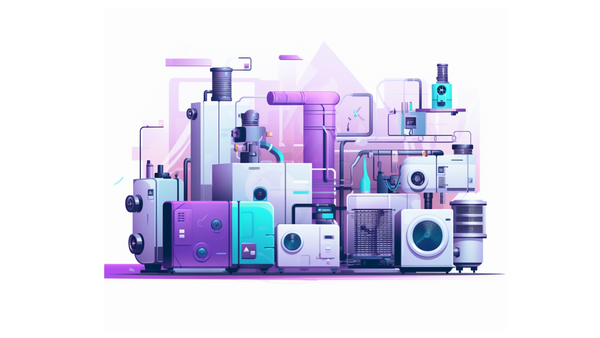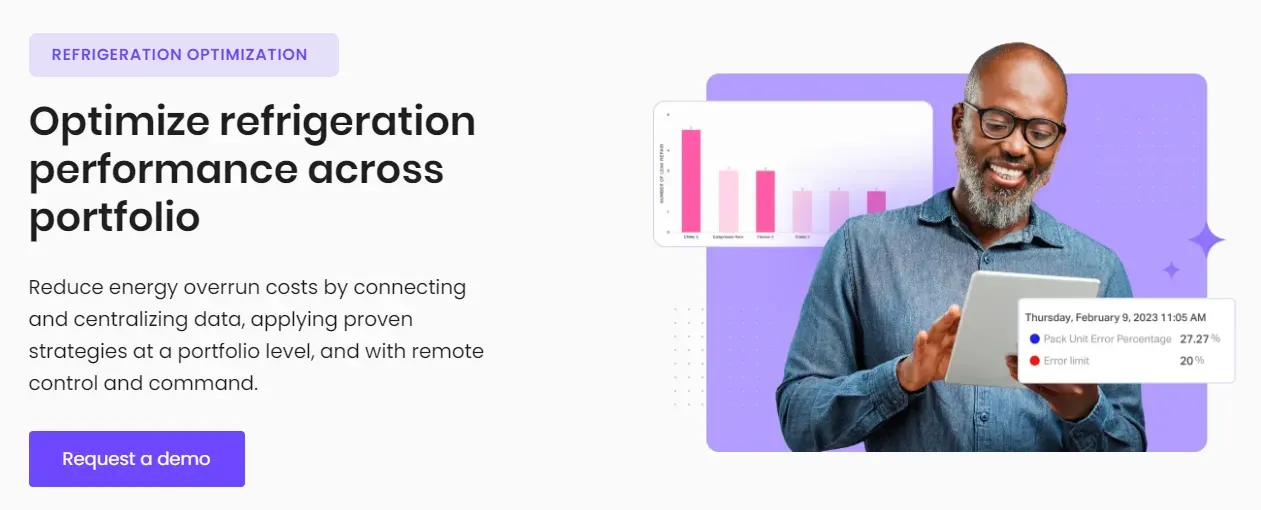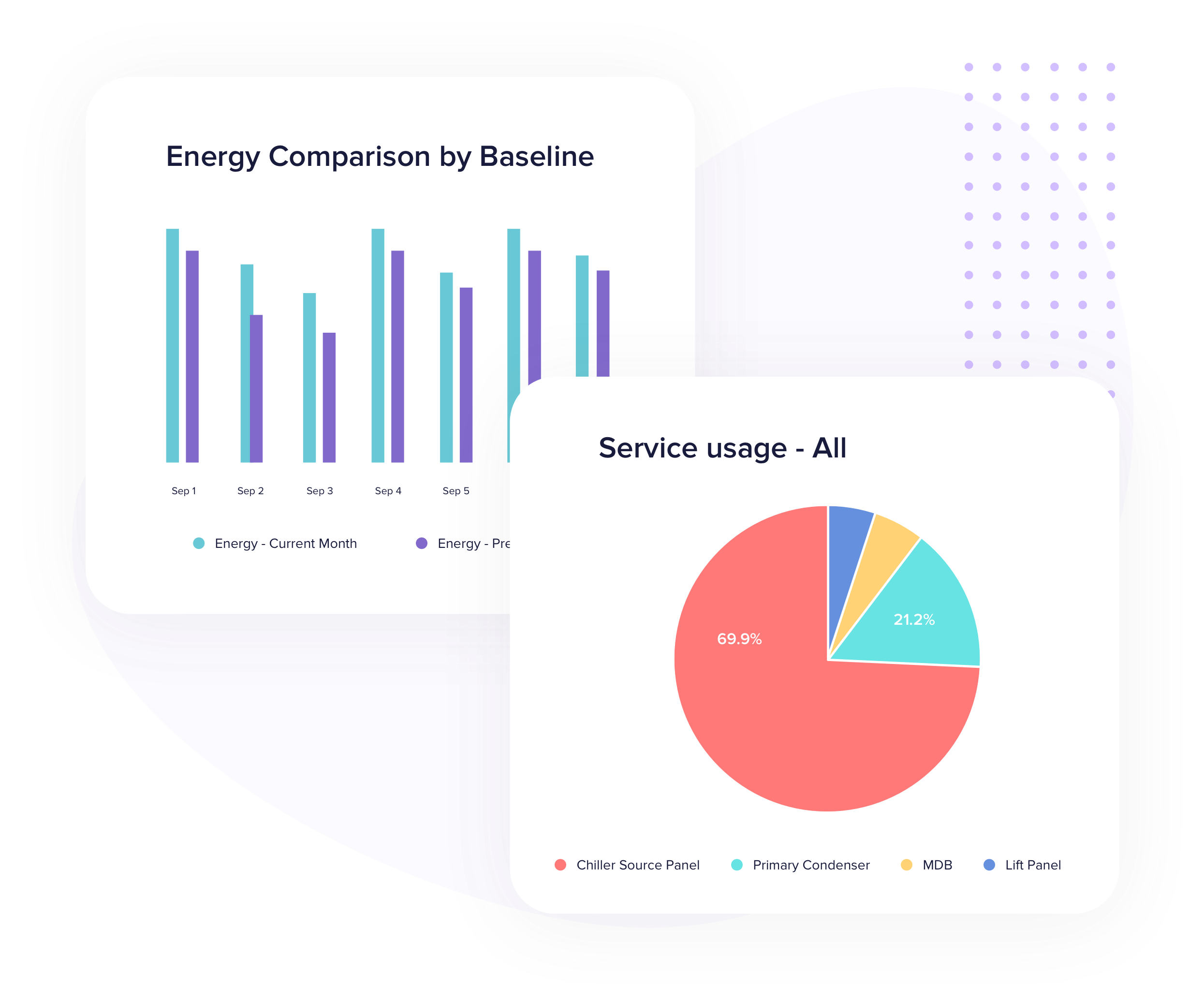Top Automated Leak Detection Systems in 2025: A Comprehensive List
The right automated leak detection software (ALD) can reduce your store's maintenance costs by 80% as per EPA’s recent Refrigeration Leak Detection Technologies report—creating substantial opportunities to enhance sustainability, regulatory compliance, and operational effectiveness.
But with numerous ALD systems available, how do you choose the right fit?
In this article, we’ll check out our extensively researched list of 10 refrigerant leak detection systems, their unique features, and ratings.
What is automated leak detection software?
It utilizes inputs from sensors placed within the equipment and detects leaks caused by liquid, vapor, or gas. The system uses parameters such as temperature, pressure, humidity, or the presence of specific substances to identify potential leaks.
Imagine you have an energy-consuming refrigeration system in one of your retail stores that has already gone through two rounds of leak repairs. An ALD system would constantly monitor the performance of the system and give you a thorough root cause analysis for the recurring leak and the necessary action to fix it.
In short, it saves you from unnecessary repairs or replacement costs and hefty fines charged up to $37,500 per day, all while protecting the environment.

Best automated leak detection software: Quick comparison
Although we haven’t personally tested every software in this guide, we’ve thoroughly researched each product that made the shortlist.
To narrow down our selections, we focused on the critical aspects of each company, such as customer feedback, brand reputation, functionality, unique offerings, and verified user ratings.
Best automated leak detection software
Here's a list of the top 10 automated refrigerant leak detection systems for 2025, tailored for efficient compliance and management across various facilities:
- Facilio
- Sphera
- Trakref
- Intelex
- Accruent
- Benchmark Gensuite
- ERA
- Parasense by MSA Safety
- RLDS by Copeland
- GRM2 by MSA Safety
Let’s go through each of them to understand their unique offerings.
1. Facilio

Facilio’s automated leak detection software is known for its Internet of Things (IoT) based tracking and automation.
It offers comprehensive solutions that streamline refrigerant compliance and leak detection, featuring advanced data analytics and sustainability reporting.
Facilio's ready-to-deploy refrigerant tracking system automatically detects leaks and provides regulations-ready actionable reporting. This helps you stay compliant with industry standards like EPA 608 regulations and the proposed American Innovation and Manufacturing Act.
Moreover, integrating Facilio with your existing controllers, ultrasonic-based leak detectors, and sensors for multi-site refrigeration optimization is a breeze.
It automates routine inspections and rounds for field teams while also providing real-time alerts to estimate liquid loss, detect leaks, and automate corrective action to prevent service repair costs. Auto-streamline refrigerant records and digitize Environmental, Social, and Governance (ESG) and sustainability reporting to always stay ahead of the curve!
User feedback
Tuten Labs, an Atlanta-based tech leader, leveraged Facilio to digitize and automate O&M across 10,000 large-format retail stores.
In the words of Roi Amszynowski, the CEO of Tuten Labs -
“By joining forces with Facilio, we are confident that we will keep generating more value and savings for all of our stakeholders.”
Rating - 4.0 ⭐️⭐️⭐️⭐ (Based on Capterra reviews)
Pricing
Facilio offers a free trial and as a comprehensive facility management solution, it offers custom pricing packages. Reach out to get a quote.
Why choose Facilio for automated leak detection
1. Stay compliant with refrigeration regulations
Facilio emphasizes the role of third-party or internal technicians in navigating complex state compliance regulations like the EPA 608, and the AIM Act. By having them enter refrigerant usage data during inspections and service work, Facilio ensures up-to-date record-keeping which prevents fines and ensures regulatory compliance.

Its rules-based AI meets the criteria for automatic leak detection as mandated by regulatory bodies like the CARB and other regulations. The AI uses these predefined rules to analyze data from refrigeration systems and identifies potential leaks based on established criteria.
Further, Facilio, with its low code/no code development allows flexibility to manage refrigerants at the asset level. It notifies about expiring refrigerants, integrates easily with EPA's Greenchill, CARB, and other state systems, and generates Scope 1 emissions reports, ensuring comprehensive sustainability and compliance management.
2. Proactive alarm management
Facilio’s automated leak detection system sniffs for refrigerant, analyzes it, and sends an alarm to facilities managers in case of an anomaly.
For example, you want to manage your supermarket chain's numerous refrigeration units to keep products fresh. Here, Facilio will continuously monitor the refrigeration units, record refrigerant levels using advanced sensors, analyze the data, and send an alarm in case of any issue.
- Detect slow leaks: Facilio uses telemetry-based slow leak detection. So the platform gathers data from your refrigeration systems—such as superheat on the condenser, suction pressure, outdoor ambiance, and various temperature or sensor data—and runs it through an algorithm. This detects potential slow leaks early on, ensuring timely intervention and maintenance.
- Integrates with other systems: Facilio easily integrates with other systems, generates custom reports, and offers flexibility to incorporate custom fields and workflows. This mosaic-like feature distinguishes Facilio as it blends with your existing systems by meeting your unique operational needs.
- AI-driven proactive leak detection & repair: AI-driven fault detection techniques detect probable leaks from a predictive maintenance model. With real-time sensor data, the system conducts root cause analysis based on historical leak event trends which forecasts potential leaks and assigns repair work orders to designated contractors.
This approach is complemented by Facilio’s ecosystem of integrated systems including maintenance, monitoring, energy, and more forming a closed loop that ensures faster issue resolution and reliable operations. From day one, Facilio’s IoT-led strategy future-proofs your operations.
Facilio's Enterprise Refrigeration Equipment & Refrigerant Management is your key to tackling the unique challenges faced by grocery and big box retailers today.
With a focus on reducing food loss, improving compliance, and enhancing facility operations efficiency, Facilio’s Connected Retail platform empowers you to thrive in a competitive market landscape.
It’s designed as a platform with the ability to offer custom modules and gives you the flexibility to customize the solution to your specific needs.
2. Sphera
Sphera is a cloud-based platform that excels in comprehensive refrigerant lifecycle management. From inventory tracking to compliance reporting, it’s suitable for diverse facility needs.
Key features
- Visibility to real-time data to spot gaps and resolve them
- Ensures comprehensive record-keeping to avoid hefty fines for non-compliance
- Ensures data integrity for refrigerant initiatives
- Automatic leak detection
- Adaptable
Limitations
- Not as user-friendly as other solutions
- Difficult navigation
Rating - 4.0 (+11 G2 ratings)
Pricing
It starts with 0.01$ and offers custom pricing packages.
It’s ideal for
FM leaders seeking automated refrigerant leak detection systems that offer a 360-degree view of sustainability parameters including effective ESG reporting.
3. Trakref
Trakref offers robust asset management capabilities and compliance tracking, making it a reliable choice for managing refrigerant inventories and equipment.
Key features
- Tracks equipment information such as leaks, repairs, and maintenance
- Gathers and centralizes equipment information to improve return on investment (ROI) and supports ESG reporting
- Identifies and closes non-compliance gaps to prevent losing money to fines
- Asset management
Limitations
- Can be expensive for smaller businesses
- Less intuitive user interface (UI)
Pricing
Reach out to the software provider for a custom quote.
It's ideal for
Businesses of all sizes and models. Whether you're a small business willing to achieve sustainability goals or are looking to support multi-site organizations with sustainability audits, it supports your needs with unlimited users.

4. Intelex
Intelex is a versatile compliance management tool that supports various regulations including refrigerant compliance, with features for reporting and analytics.
Key features
- Configurable dashboards to deliver real-time visibility into emissions
- Track and manage leak repair data
- Get notifications and alerts for leaks with actionable insights
- Monitor leak thresholds
- Pre-approves maintenance personnel
- Easy integration
- Easy to use
Limitations
- Lacks strong customer support
- Complex workflow
- Poor UI
Rating - 4.0 (+22 reviews on G2)
Pricing
Reach out to the software provider for a custom quote.
It's ideal for
Companies seeking a solution to expand risk management.
5. Accruent
Accruent provides a centralized platform for refrigerant compliance management, supporting automated alerts and critical deadline notifications ideal for businesses of all sizes.
Key features
- Easy-to-see charts on energy usage and savings trends by consolidating data from all locations
- Audit current refrigerator's set points to ensure they're running at the company standard
- Increase staff efficiency and decrease maintenance costs
- Real-time visibility of equipment throughout the refrigerant usage lifecycle
Limitations
- Not as intuitive as other solutions
- Can be expensive
Pricing
Reach out to the software provider for a custom quote; they don’t provide a free trial or a free version of the product.
Rating - 4.7 (+20 reviews by Capterra)
Pricing
Reach out to the software provider for a custom quote.
It's ideal for
Large enterprises seeking a comprehensive refrigeration management solution with real-time monitoring, a user-friendly interface, predictive maintenance capabilities, and solid customer support.
6. Benchmark Gensuite
Benchmark Gensuite facilitates efficient refrigerant tracking, leak management, and environmental health and safety solutions. It can be integrated with digital inspection templates and real-time notifications.
Key features
- Easily keeps inventory of refrigerant-related equipment
- Tracks and monitors refrigerant inspections, leaks, and reports
- Access to real-time reporting
- Updated leak management calculations for EPA compliance
Limitations
- Can be expensive
- Not as user-friendly as other available solutions
- Can take more time for new users to get used to the system
- Confusing interface
Rating - 4.0 (+11 G2 reviews)
Pricing
Reach out to the software provider for a custom quote.
It’s ideal for
FM leaders seeking comprehensive compliance management and broad operational insights into refrigeration management.
7. ERA
ERA offers a customizable and accessible platform for environmental management and regulatory adherence, featuring dashboard widgets and email alerts.
- Compliance tracking
- Emissions tracking
- Easy integration with existing systems
- Energy usage monitoring and sustainability goals and metrics
Limitations
- Less intuitive and user-friendly as compared to other solutions
- Lacks advanced analytics and reporting features
Pricing
Reach out to the software provider for a custom quote.
It’s ideal for
Organizations seeking a solution to achieve their sustainability goals with limited predictive maintenance.
8. Parasense by MSA Safety
Parasense by MSA Safety is known for its real-time analytics and automated alerts. It helps track and manage refrigerant usage effectively.
Key features
- Visibility across your enterprise
- Easy-to-use compliance software
- Combined with Parasense RTC (Refrigerant Tracking and Compliance), it achieves regulatory compliance for EPA, California Air Resources Board (CARB), and fluorinated greenhouse gasses (F-Gas) reporting
- Quick response to refrigerant leaks
Limitations
- Limited scalability
- Not as user-friendly as other solutions
Pricing
Reach out to the software provider for a custom quote.
It's ideal for
Organizations seeking specialized leak detection with its advanced sensors and compliance solutions.
9. RLDS by Copeland
RLDS by Copeland stands out with its high-precision monitoring capabilities. It’s suitable for a wide range of refrigerants, and known for its reliability in diverse environmental conditions.
Key features
- Detects leaks early to prevent fines and refrigerant discharge
- Easy integration with existing building management system (BMS) with interfaces including Modbus, LonWorks, and BACnet
- Accurately detects an array of refrigerants
- Large graphic display and LED status indicators offer easy system-wide visibility at a glance
Limitations
- Less advanced analytics and reporting features
- Not as intuitive as other solutions
Pricing
Reach out to the software provider to get a custom quote.
It’s ideal for
Facilities managers seeking operational efficiency for large-scale organizations like data centers, manufacturing, pharmaceuticals, industrial plants, etc.
10. GRM2 by MSA Safety
GRM2 by MSA Safety features multi-channel gas detection utilizing unique infrared absorption technology, offering extensive facility coverage and robust data integration capabilities.
Key features
- Detects the presence of a targeted gas down to 10 ppm MDL.
- Response to various gases including CFC, HCFC, HFC, HC, CO2, HFO
- Simple display and in-built alarm
- Access to live refrigerant leak data and automated alarm emails
Limitations
- Limited integration capabilities
- Lacks AI-driven predictive maintenance
Pricing
Reach out to the software provider to get a custom quote.
It’s ideal for
Organizations seeking a gas leak detector for their facility.
These systems provide comprehensive solutions that enhance safety, compliance, and operational efficiency across various industries and facility types.
Key capabilities of an automated leak detection software
Automated refrigerant leak detection systems offer a range of capabilities to enhance the safety, compliance, and efficiency of facilities that use refrigerants or other substances prone to leakage.
Some of the key capabilities commonly found in these systems include:
1. Real-time monitoring
Systems that continuously monitor environments for the presence of gases or liquids detect leaks as they happen, providing immediate response to prevent further escalation.
For instance, in a retail giant, Facilio monitors refrigeration units round-the-clock. When a leak is detected, it alerts maintenance teams via mobile notifications, SMS, or their preferred communication mode.
2. Automated Alerts and Notifications
Upon detecting a leak, the software sends instant alerts to the relevant personnel via SMS, email, or direct notifications on their devices. This ensures that leaks do not go unnoticed and are addressed promptly.
For priority-based alerts that align with predefined refrigerant level thresholds, incorporate Facilio. It'll notify technicians or contractors immediately(even in case of slow leaks), facilitating prompt action to mitigate potential risks.
3. Data Logging and Analysis
Automated refrigerant leak detection systems that record data over time help you identify patterns or recurrent issues. This helps in understanding the root causes of leaks and can guide preventive maintenance strategies.
It’s especially helpful if one of your store’s refrigeration units is prone to frequent leaks and repairs. In this case, a platform such as Facilio will give you historical data on the unit, notify technicians with actionable insights, and execute predefined custom workflows.
4. Integration with Building Management Systems (BMS)
Integrating an ALD with your existing BMS allows for end-to-end maintenance and easier management of multiple systems and data sources.
For example, Facilio seamlessly integrates its ALD with your existing BMS, providing a cohesive solution. Alternatively, you could leverage its connected refrigeration system for a holistic solution to refrigeration management and compliance.

5. Compliance Reporting
To stay ahead of the curve, use a system that aligns with ever-evolving industry standards. And over 300 sites across the US have trusted Facilio for this very reason.
Its compliance refrigeration software solution generates reports that help facilities comply with environmental regulations and safety standards. The platform also lets you customize these reports to meet specific regulatory requirements and get regulations-ready actionable reporting.

6. Remote Monitoring and Control
To oversee refrigeration units’ health across multiple locations, you need a system that monitors and controls the systems remotely. This capability also includes adjusting settings and responding to alerts from anywhere, enhancing operational flexibility. Facilio, for example, provides visibility into SIC events for all units, enabling prompt resolution in case of an issue.
7. Sensitivity and Accuracy
Use a solution that leverages advanced sensors and detection algorithms to provide high sensitivity and accuracy in detecting even small leaks.
Integrating Facilio’s asset management software solution, for instance, into your existing building management system will provide real-time IoT insights and optimize asset performance.
8. Proactive Maintenance and Predictive Analytics
Your automated leak detection system should use historical data and trends to predict potential future leaks and suggest maintenance activities. This proactive approach significantly reduces the risk of unexpected leaks and associated costs.
These capabilities make automated refrigerant leak detection systems an essential component of modern facility management, particularly in industries where safety and compliance are critical.
Real Also:
- Proactive Maintenance: Strategies, Benefits, and Implementation
- Predictive Analytics in Facility Maintenance
Key benefits of automated leak detection software
From installing refrigerant equipment to its disposal, automated leak detection software brings benefits at each phase of the refrigeration lifecycle.

Enhanced safety with SIC events display
These systems can quickly sniff out hazardous gas leaks, significantly reducing the risk of fire, explosions, and health issues for workers and nearby residents.
How?
By providing the ability to display System Integrity Check (SIC) events and related configuration details for thorough system monitoring. This gives store managers a clear and detailed view of the system’s status at any given time.
Cost savings
An ALD system assesses risks in terms of cost and time, triggering corrective actions like bypassing certain processes or immediate refrigerant refills. By identifying and resolving such anomalies early on, these systems prevent the loss of expensive gases and reduce the costs associated with emergency repairs and downtime. Plus it prolongs the lifespan of refrigeration equipment.
Compliance with food safety standards
ALD systems equipped with mobile-first apps instantly notify the executives and technicians of an anomaly. This proactive approach reduces compliance-related risks–ensuring adherence to food safety standards.
Environmental compliance
An automated leak detection software helps facilities comply with environmental regulations by promptly addressing and documenting leaks. It tracks compliance efficiently with condition-based maintenance and manages planned inspections, refrigerant inventory, material history, pricing, and grocery and refrigerant compliance records. (CARB, EPA 608)
This helps avoid legal penalties, maintain your company's reputation, and achieve sustainability across your stores.
Improved operational efficiency with sensor-less detection
With automated cloud strategies through advanced Fault Detection & Diagnositics, you get access to detailed health and status information of all refrigeration units, and detect slow leaks without sensors.
Data accuracy and auditing
The software provides precise and reliable data that can be used for compliance reporting and operational audits. It automatically streamlines refrigerant records and compliance data and automates report generation for stakeholders, ensuring adherence to environmental standards.
Predictive maintenance
By analyzing historical data, the software can predict potential future failures, allowing proactive maintenance scheduling. This predictive maintenance approach can prevent major failures and optimize maintenance budgets.
Remote monitoring capabilities
Facility managers can monitor systems from anywhere, providing flexibility and immediate access to information. This capability is especially beneficial for managing multiple facilities or large sites.
How to pick the right automated leak detection software for your business
Choosing the right automated leak detection software is important for the efficiency and safety of refrigeration operations. Here’s a step-by-step guide to help you make an informed decision.
Assess your specific needs
Consider the type and size of the facilities where the system will be installed, the types of refrigerants used, and their environmental impact. Evaluate the complexity of your refrigeration systems and the level of monitoring required.
For example, integrating an automated leak detection software with only your highest energy-consuming refrigeration system of all facilities. This targeted approach maximizes your initial investment and provides immediate benefits.
Research compliance requirements
Identify the regulatory requirements specific to your industry and location.
Ensure the software supports compliance with regulations, such as EPA, CARB, or F-Gas regulations, providing necessary documentation and reporting features.
Go for a solution such as Facilio, that not only complies with existing industry standards but also stays updated with evolving guidelines.
Check for integration capabilities
Ensure the software integrates with your existing BMS or heating, ventilation, and air conditioning (HVAC) systems. Look for systems that offer flexible integration with other operational technologies you use.

Facilio adopts an API-first strategy that ensures seamless integration with operational technology and IT systems, including BMS, sensors, building information modeling (BIM), customer relationship management (CRM), enterprise resource planning (ERP), and other business software.
For example, when implementing new automated refrigeration leak detection software across multiple locations like giant grocery stores, Facilio would integrate smoothly into your existing tech stack without disrupting the existing workflows.
Evaluate technical features
Check for key features, including real-time multi-site monitoring, automated alerts, data logging, predictive maintenance, and remote monitoring capabilities. Consider the accuracy and sensitivity of the sensors, as well as the system’s ability to detect small leaks.
Consider usability and support
The user interface should be intuitive and easy to use. Plus, the system should have 24/7 customer support, training resources, and system updates.
For staff members who may not be tech-savvy, intuitive and user-friendly software with robust customer support helps them use the software efficiently.
Review scalability and flexibility
The system should be scalable to accommodate future expansion or changes in your facility. So, go for software that allows customization to meet specific operational needs.
As a facilities manager overseeing five facilities, a comprehensive asset management solution might be meeting your needs. However, check whether the system can comfortably operate and manage assets for 10 facilities. If not, switch to a solution designed for larger enterprises.
Analyze cost-effectiveness
Compare the upfront costs versus long-term savings on refrigerant costs, maintenance, and potential non-compliance penalties. Consider the total cost of ownership, including installation, training, and ongoing operational costs.
Don’t simply look at the initial upfront investment. Consider how it can reduce operational costs in the long run. After all, investing in the right ALD system will optimize energy consumption and minimize overall expenses over time across all units.
FAQs
1. What are the most common signs of refrigerant leaks in retail settings?
Retail store managers often notice fluctuations in cooling performance, unexpected increases in energy bills, or even the presence of frost or ice on refrigeration lines as indicators of potential leaks. Understand these signs for prompt inspections and interventions.
2. How can automated refrigerant leak detection systems reduce operational costs in retail facilities?
Unaddressed refrigerant leaks may cost FM leaders a fortune. Automated refrigerant
leak detection systems detect such leaks early, which means the equipment undergoes less damage and reduces downtime for repairs. This, in turn, lowers the overall operational costs.
3. What should I look for in a refrigerant leak detection system to ensure compliance with environmental regulations?
Facility managers should ensure that the automated refrigerant leak detection systems provide detailed logs and reports for compliance with regulations such as the EPA's Section 608. Moreover, ensure that the system supports the detection of all refrigerants used in the facility.
4. Can automated refrigerant leak detection systems integrate with other building management systems?
Integration capabilities are a key feature for facility managers to consider. Systems that integrate seamlessly with existing building management systems allow for centralized control and monitoring, making it easier to manage alerts, detect leaks, and maintain records.
5. What are the challenges of implementing an automated leak detection system and how can they be overcome?
Primary challenges include the initial cost of installation, the complexity of integrating new technology with older systems, and training staff to use the new system effectively.
To overcome these challenges, select a system offering good technical support and training. Consider systems that are compatible with existing technologies, and ensure a phased implementation to spread out costs.


